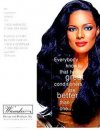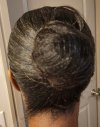sunnieb
Well-Known Member
I posted this in the Relaxer Thread a while back, but wanted to add it here. A lot of us remember Wanakee and what she meant to our haircare. She was the first I saw to advocate "hiding your hair". Like I said in the other thread, I remember getting her pamphlet in the mail and throwing it away. It was the 90s and I could not believe that a black woman with hair like mine could grow hair that long. Now we know better!
She also mentions trimming. Since it looks like I might be back to 16-18 week relaxer stretches, I think I'll start doing a min-trim at 8 weeks post. Then I'll do my regular trim when I relax. I'll see how that goes.
Anyway, here's the info from Wanakee's pamphlet:
WANAKEE'S PRACTICAL GUIDE TO HAIR CARE





INTRODUCTION
If your hair has been damaged, take heart. Your hair is growing while you’re reading this. It was growing yesterday while you were having dinner, and it will be growing during your coffee break. If you've ever had a relaxer or hair color in your hair you know how fast it grows; seems like you need your roots touched up every time you blink! Yet women constantly say, "My hair just won’t grow. Why doesn't it ever get any longer?"
In order for your hair to grow, it has to have what I call a ‘healthy growth pattern’. Here’s what a healthy growth pattern looks like: Grow, grow, grow, trim. Grow, grow, grow, trim. Grow, grow, grow, trim. Notice, there’s three times more growing going on here than trimming.
An ‘unhealthy growth pattern’ looks like this: Grow, break, grow, break. Grow, break, grow, break. There’s as much breakage going on here, as there is growth. You can see clearly that the hair is growing. But it’s breaking just as fast as it grows; the breakage is NEUTRALIZING the growth, making it appear as if it’s not growing at all! So what’s causing all the breakage? Dry, brittle hair.
THE MAIN REASON FOR DRY HAIR
You’ll notice that after you trim your hair, the ends seem dry again almost immediately! You’d think it was because of too much heat or blow-drying or maybe a bad perm. Although these treatments can sometimes dry out your hair, they only happen occasionally. The process that happens everyday, drying out your hair is...exposure to the air!
Yes, something that simple can be sapping your hair of life. Think for a moment; air dries your laundry, it cracks your house paint, it chaps your lips, it ashes your skin; it’s a serious drying agent. And when you wear you hair down regularly, air dries out your hair too. The movement of your hair against your clothing can dry your ends even more; and when ends get dry, they break off.
Picture an ear of corn with the husk on it. Did you ever notice how awful the silk looks that’s hanging on the outside of husk? But if you peel the husk down, the silk is soft, shiny and in excellent condition. The only difference is that the top silk has been exposed to the air, while the silk inside the husk has not. Air can cause damage to your hair. Moisture and Oil for the Hair is a light daily application of protection against dryness that adds a gorgeous shine and allows the hair to remain clean feeling. It’s nice.
DEVELOPING A HEALTHY GROWTH PATTERN
Since the ends are the oldest part of your hair, they suffer the most from this constant exposure to air. You can end the breakage cycle and experience a healthy growth pattern by following these simple rules. They may not seem very significant at a glance, but they are the steps that restored my damaged strands to a full, healthy head of hair. Remember that you want to preserve the ends while the roots grow. Being consistent and patient every day is the key to your success.
1. KEEP YOU HAIR CLEAN AND CONDITION IT, CONDITION IT, CONDITION IT!
If you wash your hair less frequently than 7 days or so, the scalp may get irritated and begin to itch. And when dirt begins to build up on the strand, it slows down the brush or comb, creating a pulling affect, which can snap hairs. You’ll find that Deep conditioning at least once a week make the hair easy to comb through when the hair is wet and when it’s dry.
2. WEAR YOUR HAIR IN PROTECTIVE HAIR STYLES AS OFTEN AS YOU CAN
This means wearing your hair ‘up’ in a style that tucks the ends safely underneath the hair so the ends are not seen. Remember the ear of corn with the husk again: protective styling is like taking the dry tip of the silk, and tucking it safely underneath the husk, out of the air. But if your ends go up dry, they’ll come down dry.
My favorite protective styles are the French twist and the chignon (or bun). You should not be able to see the ends at all. A ponytail, for example, wouldn't be considered a protective style because the ends are moving and still exposed to the air. You can really have fun creating these styles, using all types of accessories and enhancing your look with simple things like earrings or a newly tweezed set of eyebrows! You can make your look clean or really do yourself up. Have fun with it.
If your hair is short, you’re going to protect your hair from the air and from too much movement while you sleep.
3. SLEEP WITH YOUR HAIR PROTECTED AT NIGHT.
I know, I know! This is where I lose a lot of you ladies who have spouses; but hear me out. It's important at night, again, to take your hair out of the air and especially to eliminate all of the rubbing that takes place while you sleep. This rubbing can be bad news in the morning when your ends are frayed beyond recognition. A good thing about wrapping (or tying up) your hair at night is that it requires less styling the next day (sometimes you’re actually ready to go with just a quick stroke of the brush).
If you’ve read my brochure, you've heard me say that wrapping your head at night need not be grounds for divorce. You can use a fine meshed hair net over your bun or over your hair if it’s short, and then apply a wide cotton spandex headband around the hairline. It looks similar to a regular daytime look. If you’re still not loving the idea, my next best advice is to put it on late and take it off early! By the way, just sleeping on a silk pillowcase won’t help if your hair is still moving around and exposed to the air.
If your wrap comes off, and at some point it probably will (especially if your hair is short), half a night’s protection is better than none. But this simple, traditional routine of tying the hair up at night is still a very helpful method in maintaining your hair.
4. GET YOUR HAIR TRIMMED EVERY 6 TO 8 WEEKS.
If you’re trying to grow your hair out, this is where protective styles really pay off. Your hair grows ¼ to ½ inch per month, so in 8 weeks it could have grown 1 inch. Let’s say you started your routine with a real good trim. And now, 8 weeks later it’s time for another trim. If you have been conditioning, using your Constant Care for Ends and wearing your protective styles everyday, your ends shouldn't even be split. So now you’re going to trim your hair before it splits. You only have to trim ¼ inch or so because it’s not split. That means you have ¾ of an inch of new length. You put those brand-new, freshly trimmed ends right back up into your protective styles and next month you’ll accumulate another ¾ of an inch - that’s 1 and ½ inches of real length in four months!
Now let’s look at what happens if you don’t wear protective styles. You wear your hair down, it rubs all day against your shoulders and the air makes it dry - but it looks good, I understand.
But here’s what happens: you go to get your trim in 8 weeks and you really only want the hairdresser to take ¼ of an inch off. But she sees damage and split ends as far up as an 1 and ½ inches. She cuts the damage off and, even though your hair has grown an inch, you just lost ½ inch in length because the constant damage caused by your ends being exposed DICTATED TO YOU how much hair had to be cut. With protective styling, you trim before your hair splits and you determine how much you trim off. Every little quarter of an inch is a victory.
Some women have asked me, "What is the point of having long hair if you have to wear it up?" The point of wearing it up is to have long hair. Once a young lady asked, "About how long would it take for me to grow my hair really long?" I told her it would take about 4 years with regular trimmings. She said "Four years? I’ll be 34 years old in four years, that’s too much time!" I had to remind her that she was going to be 34 years old in four years anyway; might as well get there having fabulous hair.
If you have short hair, don’t let all this talk of protective styles disturb you. If you keep your hair cut short and trimmed on a regular basis, it’s automatically healthier by being trimmed more often. It's when hair becomes long that the protective styles become necessary. If you’re not growing your hair long, but are keeping it trimmed and styled at a fixed length, then you can get away with wearing it down more often than the person who is on a mission to grow long hair.
She also mentions trimming. Since it looks like I might be back to 16-18 week relaxer stretches, I think I'll start doing a min-trim at 8 weeks post. Then I'll do my regular trim when I relax. I'll see how that goes.
Anyway, here's the info from Wanakee's pamphlet:
WANAKEE'S PRACTICAL GUIDE TO HAIR CARE





INTRODUCTION
If your hair has been damaged, take heart. Your hair is growing while you’re reading this. It was growing yesterday while you were having dinner, and it will be growing during your coffee break. If you've ever had a relaxer or hair color in your hair you know how fast it grows; seems like you need your roots touched up every time you blink! Yet women constantly say, "My hair just won’t grow. Why doesn't it ever get any longer?"
In order for your hair to grow, it has to have what I call a ‘healthy growth pattern’. Here’s what a healthy growth pattern looks like: Grow, grow, grow, trim. Grow, grow, grow, trim. Grow, grow, grow, trim. Notice, there’s three times more growing going on here than trimming.
An ‘unhealthy growth pattern’ looks like this: Grow, break, grow, break. Grow, break, grow, break. There’s as much breakage going on here, as there is growth. You can see clearly that the hair is growing. But it’s breaking just as fast as it grows; the breakage is NEUTRALIZING the growth, making it appear as if it’s not growing at all! So what’s causing all the breakage? Dry, brittle hair.
THE MAIN REASON FOR DRY HAIR
You’ll notice that after you trim your hair, the ends seem dry again almost immediately! You’d think it was because of too much heat or blow-drying or maybe a bad perm. Although these treatments can sometimes dry out your hair, they only happen occasionally. The process that happens everyday, drying out your hair is...exposure to the air!
Yes, something that simple can be sapping your hair of life. Think for a moment; air dries your laundry, it cracks your house paint, it chaps your lips, it ashes your skin; it’s a serious drying agent. And when you wear you hair down regularly, air dries out your hair too. The movement of your hair against your clothing can dry your ends even more; and when ends get dry, they break off.
Picture an ear of corn with the husk on it. Did you ever notice how awful the silk looks that’s hanging on the outside of husk? But if you peel the husk down, the silk is soft, shiny and in excellent condition. The only difference is that the top silk has been exposed to the air, while the silk inside the husk has not. Air can cause damage to your hair. Moisture and Oil for the Hair is a light daily application of protection against dryness that adds a gorgeous shine and allows the hair to remain clean feeling. It’s nice.
DEVELOPING A HEALTHY GROWTH PATTERN
Since the ends are the oldest part of your hair, they suffer the most from this constant exposure to air. You can end the breakage cycle and experience a healthy growth pattern by following these simple rules. They may not seem very significant at a glance, but they are the steps that restored my damaged strands to a full, healthy head of hair. Remember that you want to preserve the ends while the roots grow. Being consistent and patient every day is the key to your success.
1. KEEP YOU HAIR CLEAN AND CONDITION IT, CONDITION IT, CONDITION IT!
If you wash your hair less frequently than 7 days or so, the scalp may get irritated and begin to itch. And when dirt begins to build up on the strand, it slows down the brush or comb, creating a pulling affect, which can snap hairs. You’ll find that Deep conditioning at least once a week make the hair easy to comb through when the hair is wet and when it’s dry.
2. WEAR YOUR HAIR IN PROTECTIVE HAIR STYLES AS OFTEN AS YOU CAN
This means wearing your hair ‘up’ in a style that tucks the ends safely underneath the hair so the ends are not seen. Remember the ear of corn with the husk again: protective styling is like taking the dry tip of the silk, and tucking it safely underneath the husk, out of the air. But if your ends go up dry, they’ll come down dry.
My favorite protective styles are the French twist and the chignon (or bun). You should not be able to see the ends at all. A ponytail, for example, wouldn't be considered a protective style because the ends are moving and still exposed to the air. You can really have fun creating these styles, using all types of accessories and enhancing your look with simple things like earrings or a newly tweezed set of eyebrows! You can make your look clean or really do yourself up. Have fun with it.
If your hair is short, you’re going to protect your hair from the air and from too much movement while you sleep.
3. SLEEP WITH YOUR HAIR PROTECTED AT NIGHT.
I know, I know! This is where I lose a lot of you ladies who have spouses; but hear me out. It's important at night, again, to take your hair out of the air and especially to eliminate all of the rubbing that takes place while you sleep. This rubbing can be bad news in the morning when your ends are frayed beyond recognition. A good thing about wrapping (or tying up) your hair at night is that it requires less styling the next day (sometimes you’re actually ready to go with just a quick stroke of the brush).
If you’ve read my brochure, you've heard me say that wrapping your head at night need not be grounds for divorce. You can use a fine meshed hair net over your bun or over your hair if it’s short, and then apply a wide cotton spandex headband around the hairline. It looks similar to a regular daytime look. If you’re still not loving the idea, my next best advice is to put it on late and take it off early! By the way, just sleeping on a silk pillowcase won’t help if your hair is still moving around and exposed to the air.
If your wrap comes off, and at some point it probably will (especially if your hair is short), half a night’s protection is better than none. But this simple, traditional routine of tying the hair up at night is still a very helpful method in maintaining your hair.
4. GET YOUR HAIR TRIMMED EVERY 6 TO 8 WEEKS.
If you’re trying to grow your hair out, this is where protective styles really pay off. Your hair grows ¼ to ½ inch per month, so in 8 weeks it could have grown 1 inch. Let’s say you started your routine with a real good trim. And now, 8 weeks later it’s time for another trim. If you have been conditioning, using your Constant Care for Ends and wearing your protective styles everyday, your ends shouldn't even be split. So now you’re going to trim your hair before it splits. You only have to trim ¼ inch or so because it’s not split. That means you have ¾ of an inch of new length. You put those brand-new, freshly trimmed ends right back up into your protective styles and next month you’ll accumulate another ¾ of an inch - that’s 1 and ½ inches of real length in four months!
Now let’s look at what happens if you don’t wear protective styles. You wear your hair down, it rubs all day against your shoulders and the air makes it dry - but it looks good, I understand.
But here’s what happens: you go to get your trim in 8 weeks and you really only want the hairdresser to take ¼ of an inch off. But she sees damage and split ends as far up as an 1 and ½ inches. She cuts the damage off and, even though your hair has grown an inch, you just lost ½ inch in length because the constant damage caused by your ends being exposed DICTATED TO YOU how much hair had to be cut. With protective styling, you trim before your hair splits and you determine how much you trim off. Every little quarter of an inch is a victory.
Some women have asked me, "What is the point of having long hair if you have to wear it up?" The point of wearing it up is to have long hair. Once a young lady asked, "About how long would it take for me to grow my hair really long?" I told her it would take about 4 years with regular trimmings. She said "Four years? I’ll be 34 years old in four years, that’s too much time!" I had to remind her that she was going to be 34 years old in four years anyway; might as well get there having fabulous hair.
If you have short hair, don’t let all this talk of protective styles disturb you. If you keep your hair cut short and trimmed on a regular basis, it’s automatically healthier by being trimmed more often. It's when hair becomes long that the protective styles become necessary. If you’re not growing your hair long, but are keeping it trimmed and styled at a fixed length, then you can get away with wearing it down more often than the person who is on a mission to grow long hair.


 I think I kind of haphazardly twirled my hair up before bed and the curl wasn't what I wanted. I don't know. Just wasn't feeling it. So, what am I most comfortable with? My daily bun!
I think I kind of haphazardly twirled my hair up before bed and the curl wasn't what I wanted. I don't know. Just wasn't feeling it. So, what am I most comfortable with? My daily bun!